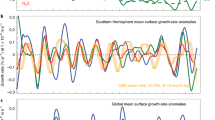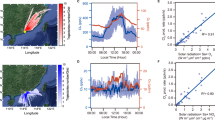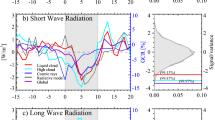Abstract
We have reported the observation of millimetre-wave emission from abnormally high concentrations of chlorine monoxide, ClO, in the lower stratosphere over McMurdo Station, Antarctica during the period 1–22 September 1986 and demonstrated1 its diurnal behaviour. Here we report on the secular variation of daytime ClO in the lower stratosphere with a time resolution of 4 or 5 days, during the period 1 September to 16 October. We show that the ClO concentration declines during the latter half of September and disappears by early October. As ClO is directly involved in a catalytic ozone destruction cycle, these observations give evidence that the Antarctic ozone hole2 is caused by a chemical depletion mechanism which operates in the early spring. This is also consistent with models in which large quantities of ClO are maintained through chemical reactions3–5 on the surface of polar stratospheric cloud particles which evaporate with the warming of the stratosphere.
This is a preview of subscription content, access via your institution
Access options
Subscribe to this journal
Receive 51 print issues and online access
$199.00 per year
only $3.90 per issue
Buy this article
- Purchase on Springer Link
- Instant access to full article PDF
Prices may be subject to local taxes which are calculated during checkout
Similar content being viewed by others
Author information
Authors and Affiliations
Rights and permissions
About this article
Cite this article
Solomon, P., Connor, B., de Zafra, R. et al. High concentrations of chlorine monoxide at low altitudes in the Antarctic spring stratosphere: secular variation. Nature 328, 411–413 (1987). https://doi.org/10.1038/328411a0
Received:
Accepted:
Issue Date:
DOI: https://doi.org/10.1038/328411a0
This article is cited by
-
Unprecedented Arctic ozone loss in 2011
Nature (2011)
-
The stability and photochemistry of dimers of the ClO radical and implications for Antarctic ozone depletion
Nature (1988)
-
Causes of ozone depletion
Nature (1988)
-
Formation of the Antarctic ozone hole by the CIO dimer mechanism
Nature (1988)
-
Extremely low N2O concentrations in the springtime stratosphere at McMurdo Station, Antarctica
Nature (1988)
Comments
By submitting a comment you agree to abide by our Terms and Community Guidelines. If you find something abusive or that does not comply with our terms or guidelines please flag it as inappropriate.



